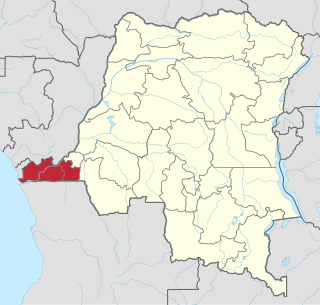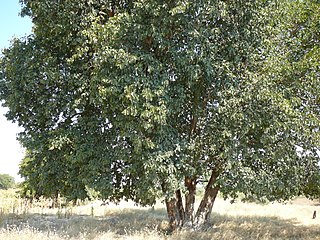
Kongo Central, formerly Bas-Congo is one of the 26 provinces of the Democratic Republic of the Congo. Its capital is Matadi.

The subfamily Detarioideae is one of the subdivisions of the plant family Fabaceae (legumes). This subfamily includes many tropical trees, some of which are used for timber or have ecological importance. The subfamily consists of 84 genera, most of which are native to Africa and Asia. Pride of Burma and tamarind are two of the most notable species in Detarioideae. It has the following clade-based definition:
The most inclusive crown clade containing Goniorrhachis marginataTaub. and Aphanocalyx cynometroidesOliv., but not Cercis canadensisL., Duparquetia orchidaceaBaill., or Bobgunnia fistuloides(Harms) J. H. Kirkbr. & Wiersema.
Astropanax is a genus of flowering plants in the family Araliaceae, native to Tropical Africa, Madagascar, and other Indian Ocean islands. It was resurrected from Schefflera in 2017.

Baikiaea is a genus of flowering plants in the legume family, Fabaceae. It includes six species of trees native to sub-Saharan Africa. Species range from Nigeria eastwards to Uganda and Tanzania and south to Zimbabwe, Botswana, and Namibia. Habitats range from lowland tropical rain forest to seasonally dry forest and woodland or savannas on well-drained soils.

Berlinia is a genus of flowering plants in the family Fabaceae. It includes 21 species of trees native to sub-Saharan Africa, ranging from Guinea to Chad, Tanzania, Mozambique, and Angola.
Englerodendron is a small genus of legumes belonging to the family Fabaceae, that are native to tropical Africa.
Tetraberlinia tubmaniana is a species of plant in the family Fabaceae. It is found only in Liberia. The tree is harvested from the wild for its wood, which is used locally and also traded. The species is especially interesting for forestry because of the high densities in which it occurs. In old stands the exploitable timber per hectare can be as high as 70 cubic metres.
Tetraberlinia is a genus of plants in the family Fabaceae.

Dombeya is a flowering plant genus. Traditionally included in the family Sterculiaceae, it is included in the expanded Malvaceae in the APG and most subsequent systematics. These plants are known by a number of vernacular names which sometimes, misleadingly, allude to the superficial similarity of flowering Dombeya to pears or hydrangeas. Therefore, the genus as a whole is often simply called dombeyas. The generic name commemorates Joseph Dombey (1742–1794), a French botanist and explorer in South America, involved in the notorious "Dombey affair", embroiling scientists and governments of France, Spain, and Britain for more than two years.

Stylochaeton is a genus of flowering plants in the family Araceae that is endemic to Africa. Stylochaeton are rhizomatous with hastate leaves. Flowering in this genus is said to be quite uncommon. Stylochaeton is the sole genus in the tribe Stylochaetoneae.
Aphanocalyx is a genus of flowering plants in the family Fabaceae. It belongs to the subfamily Detarioideae. It includes 14 species native to tropical Africa, ranging from Sierra Leone to Côte d'Ivoire, and from Cameroon to Angola and Tanzania.

Haumania is a genus of plants native to parts of central Africa. As of March 2022, Kew and Plants of the World Online accepts that it only contains 3 recognized species:
Farquharia is a genus of flowering plants in the family Apocynaceae, first described as a genus in 1912. It contains only one recognized species, Farquharia elliptica, native to tropical western and central Africa.
Baphiastrum is a genus of flowering plants in the legume family (Fabaceae). It includes a single species, Baphiastrum brachycarpum, a liana native to west-central Africa. It grows in Guineo-Congolian forest in Cameroon, Gabon, Republic of the Congo, Central African Republic, and Democratic Republic of the Congo.
Baphia pilosa is a species of flowering plant in the legume family, Fabaceae. It is a climber native to Guineo-Congolian forest in west-central Africa, ranging from Cameroon through mainland Equatorial Guinea, Gabon, Republic of the Congo, and Cabinda to the Democratic Republic of the Congo.

Brachystegia laurentii, a plant in the family Fabaceae, is a species of large tree found in western Cameroon, Gabon, Equatorial Guinea, the Democratic Republic of the Congo and the Republic of the Congo. It has a dense, umbrella-shaped crown. The wood is known as bomanga and has many uses in building and construction.
Phyllobotryon is a genus of flowering plants belonging to the family Salicaceae.

Ritchiea is a genus of flowering plants belonging to the family Capparaceae.
Poggea is a genus of flowering plants belonging to the family Achariaceae.

Annea is a genus of flowering plants in the pea family (Fabaceae). It includes two species of shrubs or trees which are native to west and west-central Africa.









